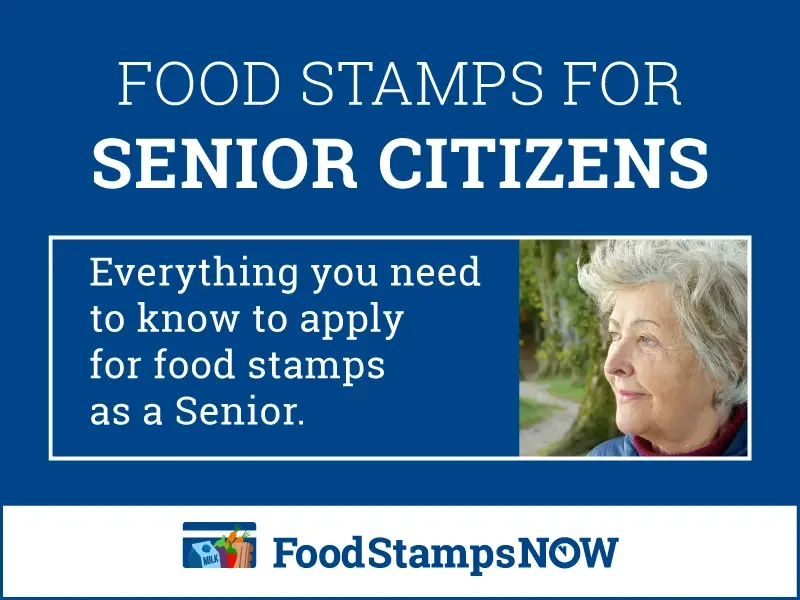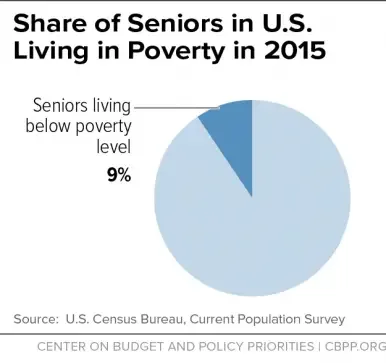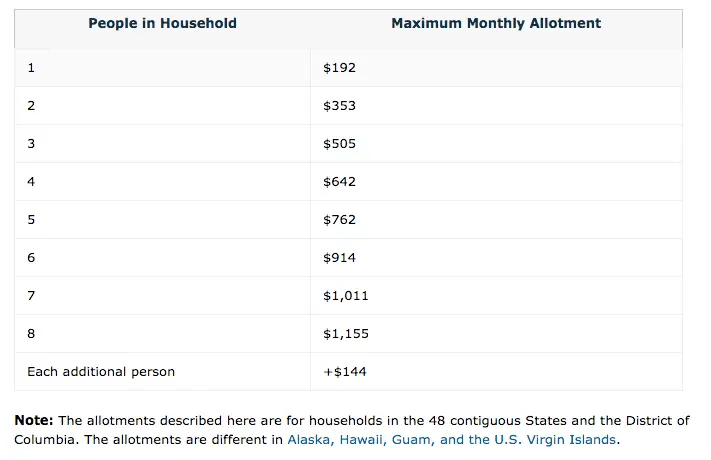Many senior citizens are not aware that they can apply for food stamps. That’s because there is a misconception out there that seniors, especially those on social security cannot apply for other government benefits like food stamps. In this post, we will explain food stamps for seniors, including how to apply, income limit and resources available to help seniors apply for SNAP/food stamps benefits.
This Post Will Cover:
Growing Number of Seniors Living in Poverty
As the population of seniors continues to grow rapidly, so is the number of seniors living in poverty, without enough food to eat.
In fact, millions of older Americans are at risk for hunger. In 2014, 10.2 million older Americans faced the threat of hunger, representing 15.8% of adults aged 60+ in the U.S.
The National Council on Aging estimates that over 25 million Americans aged 60+ are economically insecure—living at or below 250% of the federal poverty level.
These older adults struggle with rising housing and health care bills, inadequate nutrition, lack of access to transportation, diminished savings, and job loss.
Low Food Stamps Participating Among Seniors
In 2015, there were 4.8 million seniors on food stamps (ages 60 and older), On average, they receive $106 per month to help put food on the table.
However, only 42% of eligible seniors are taking advantage of this important public benefit. That compares to 83% for the general population.
Essentially, 3 out of 5 older adults (age 60+) who are eligible for Food Stamps are not enrolled.
This means that there are 5.2 million seniors who were eligible for food stamps but are not participating.
There are many reasons for this low participation rate among seniors in the program and we have detailed them in our article here.
5 Myths About Food Stamps for Seniors
As has been stated above, there are several myths about food stamps (SNAP Benefits) that have prevented many seniors from participating in the program.
Here are the five most common, courtesy of the National Council on Aging.
Myth #1: SNAP is only for families with children.
SNAP is for everyone who qualifies, including seniors.
Myth #2: Other people need SNAP more than I do; I don‘t want to take away food from a hungry child.
Everyone who is eligible for SNAP and enrolls in the program will get help. A senior who gets SNAP does not take away money or food from a household with children.
Myth #3: SNAP is not worth applying for because I will only get $15 a month.
$15 is the minimum monthly amount that a senior can receive through SNAP. Roughly 80 percent of seniors get more than that. In fact, the average senior living alone who qualifies for SNAP receives $119 each month to help pay for food. Also, people with SNAP are allowed to let their money accrue, so a small amount can add up over several months. Finally, seniors can deduct excess medical expenses from their income, which often helps them qualify for more money each month.
Myth #4: I don‘t want everyone to see me using SNAP in a grocery store.
Unlike past Food Stamps, SNAP comes loaded onto an EBT (electronic benefits transfer) card. You use the EBT card exactly like you would a credit or debit card, so most people will not know the difference. And with over 250,000 grocery stores and farmers markets accepting SNAP across the country, you have a broad choice in where to use it.
Myth #5: Applying for SNAP is too difficult.
Depending on where you live, you can apply online, by mail or in person and get one-on-one help if you need it.
Food Stamps for Seniors
The first step to applying for food stamps is to determine if you are eligible. You must meet certain requirements, including resource and income limits, as described below.
Eligibility Requirements
Here are the eligibility requirements you have to meet in order to be approved for food stamps:
Who is Considered A Senior Citizen?
For food stamps purposes, you are considered a senior if you are 60 years or older.
Food Stamps Income limit
The income test is required for all households applying for food stamps, unless all members are receiving TANF, SSI, or some other form of cash assistance from the federal government or your state.
In addition, most households must meet both the gross and net income tests, but a household with an elderly person or a person who is receiving certain types of disability payments only has to meet the net income test.
As you can see, both the gross monthly income and the net monthly income calculations are based on the number of people living in your household and rises as you add an additional member.
Resources
Households may have $2,250 in countable resources (such as cash or money in a bank account) or $3,500 in countable resources if at least one member of the household is age 60 or older, or is disabled.
However, certain resources are NOT counted when determining eligibility for Food Stamps, this includes:
- A home and lot;
- Resources of people who receive Supplemental Security Income (SSI);
- Resources of people who receive Temporary Assistance for Needy Families (TANF; also known as welfare); and
- Most retirement and pension plans (withdrawals from these accounts may count as either income or resources depending on how often they occur).
Help for Seniors Applying for Food Stamps
There are several resources available to help seniors apply for food stamps. Here are two main resources groups we highly recommend:
1. National Council on Aging (NCOA)
The National Council on Aging has done a great job in providing resources to help seniors apply for food stamps. They have made it relatively easy to go through the process.
Visit www.BenefitsCheckUp.org/getSNAP to download your state’s application and find contact information for help.
2. Community-Based Organizations
There are thousands of community-based organizations across the country that offer assistance to seniors apply for government benefits, including food stamps.
Here are organization types in your local area that are likely to offer assistance to seniors applying for food stamps:
- Community Agencies on Aging
- Aging and Disability Resource Centers
- State Health Insurance Assistance Programs (SHIPs)
- Ethnic Community Based organizations
- Anti-Hunger Community-Based Organizations
- Food Banks
- Faith-Based Organizations
- Senior Centers
Documents You Need to Apply
Here are the documents you would likely need when you apply for food stamps for seniors:
- Documents Showing Number of People Living in Household
- Documents Showing Household Address
- Documents Showing Household Expenses
- Documents Showing Medical Costs
- Social Security Receipts
- Proof of Age
- Proof of Income (If Applicable)
How much Food Stamps will I get?
Here is how much you may receive in food stamps if you are approved for benefits:
Apply for Food stamps for Seniors
If you qualify for food stamps for seniors, you must apply in the state where you live. Scroll down below to locate your state and get the information you need to apply for food stamps.
For each state listed, we have provided information on:
- How to Apply for Food Stamps Online
- A link to the Food Stamps Application form for each state (where applicable)
- A link to the Food Stamps website for your state (the state agency that runs the food stamps program)
- The phone number(s) for the state agency that runs the food stamps program.
You can call the number to ask any questions about the application process and also find out if you can apply for food stamps by phone.
Alabama
Food Stamps Website
Application Form for Seniors
State Hotline at (800) 382-0499 or (334) 242-1310
Alaska
Food Stamps Website
Application Form
State Hotline at (907) 465-3347
Arizona
Food Stamps Website
Application Form
State Hotline at (855) 432-7587
Arkansas
Food Stamps Website
Application Form
State Hotline at (800) 482-8988
California
Food Stamps Website
Application Form
State Hotline at (877) 847-FOOD (3663)
Colorado
Food Stamps Website
Application Form
State Hotline at (855) 855-4626 or call (800) 536-5298
Connecticut
Food Stamps Website
Application Form
State Hotline at (866) 974-SNAP
Delaware
Food Stamps Website
Application Form
State Hotline at (800) 372-2022 or (302) 255-9500
District of Columbia
Food Stamps Website
Application Form
State Hotline at (202) 727-5355
Florida
Food Stamps Website
Apply Online
State Hotline at (866) 762-2237
Georgia
Food Stamps Website
Application Form
State Hotline at (800) 869-1150 or (877) 423-4746
Hawaii
Food Stamps Website
Application Form
State Hotline at (855) 643-1643
Idaho
Food Stamps Website
Application Form
State Hotline at (877) 456-1233
Illinois
Food Stamps Website
Application Form
State Hotline at (800) 843-6154 or (800) 447-6404
Indiana
Food Stamps Website
Application Form
State Hotline at (800) 403-0864
Iowa
Food Stamps Website
Application Form
State Hotline at (877) 937-3663 or call (877) 347-5678
Kansas
Food Stamps Website
Application Form
State Hotline at (888) 369-4777
Kentucky
Food Stamps Website
Application Form
State Hotline at (855) 306-8959
Louisiana
Food Stamps Website
Application Form
State Hotline at (888) LA HELPU (524-3578)
Maine
Food Stamps Website
Application Form
State Hotline at (800) 442-6003
Maryland
Food Stamps Website
Application Form
State Hotline at (800) 332-6347
Massachusetts
Food Stamps Website
Application Form for Seniors
State Hotline at (866) 950-3663
Michigan
Food Stamps Website
Application Form
State Hotline at (855) 275-6424
Minnesota
Food Stamps Website
Application Form for Seniors
State Hotline at (888) 711-1151 or (800) 657-3698
Mississippi
Food Stamps Website
Application Form
State Hotline at (800) 948-3050
Missouri
Food Stamps Website
Application Form
State Hotline at (855) 373-4636
Montana
Food Stamps Website
Application Form
State Hotline at (800) 332-2272
Nebraska
Food Stamps Website
Application Form
State Hotline at (800) 383-4278
Nevada
Food Stamps Website
Application Form
State Hotline at (800) 992-0900
New Hampshire
Food Stamps Website
Application Form
State Hotline at (800) 852-3345 (ext. 9700) or (603) 271-9700
New Jersey
Food Stamps Website
Application Form
State Hotline at (800) 687-9512
New Mexico
Food Stamps Website
Application Form
State Hotline at (800) 432-6217
New York
Food Stamps Website
Application Form
State Hotline at (800) 342-3009 (in-state only) or (718) 557-1399 (NYC only)
North Carolina
Food Stamps Website
Application Form
State Hotline at (866) 719-0141
North Dakota
Food Stamps Website
Application Form
State Hotline at (800) 755-2716 (in-state only) or (701) 328-2328
Ohio
Food Stamps Website
Application Form
State Hotline at (866) 244-0071
Oklahoma
Food Stamps Website
Application Form
State Hotline at (866) 411-1877 or (405) 521-3444
Oregon
Food Stamps Website
Application Form
State Hotline at (800) 723-3638 or (503) 945-5600
Pennsylvania
Food Stamps Website
Application Form
State Hotline at (800) 692-7462 or (800) 451-5886 (TDD)
Rhode Island
Food Stamps Website
Application Form for Seniors
State Hotline at (401) 462-5300
South Carolina
Food Stamps Website
Application Form for Seniors
State Hotline at (800) 616-1309
South Dakota
Food Stamps Website
Application Form
State Hotline at (877) 999-5612
Tennessee
Food Stamps Website
Application Form
State Hotline at (866) 311-4287
Texas
Food Stamps Website
Application Form
State Hotline at (877) 541-7905 or 211 (in-state only) or (512) 973-9203 (select option 2)
Utah
Food Stamps Website
Application Form
State Hotline at (866) 526-3663
Vermont
Food Stamps Website
Apply Online
State Hotline at (800) 287-0589
Virginia
Food Stamps Website
Application Form
State Hotline at (800) 552-3431 or (804) 726-7000
Washington
Food Stamps Website
Application Form
State Hotline at (877) 514-Food (3663) (in-state only) or (877) 501-2233
West Virginia
Food Stamps Website
Application Form
State Hotline at (800) 642-8589
Wisconsin
Food Stamps Website
Application Form
State Hotline at (800) 362-3002
Wyoming
Food Stamps Website
Application Form
State Hotline at (800) 457-3659 or (307) 777-5846
What Happens After I Apply?
In most cases, once you submit your application, your State agency or local Food Stamps office will process it and send you a notice telling you whether or not you are eligible for benefits within 30 days.
During the 30 days, you will need to complete an eligibility interview and provide verification of the information you submitted during the application.
The interview is typically completed over the telephone or in-person.
If you are approved for benefits, the start date for your benefits will be the date you submitted your application.
How Will I receive Food Stamps?
If you are approved for Food Stamps, you will receive your benefits on an Electronic Benefits Transfer (EBT) card, which works like a debit card.
Your benefits are automatically loaded into your account each month. You can use your EBT card to eligible foods at authorized food stores and retailers.
How long will I receive Food Stamps?
After you are approved for food stamps, you will receive a notice that tells you how long you will receive benefits for. This is called your certification period.
Before your certification period ends, you will receive another notice that says you must recertify to continue receiving benefits.
Your local Food Stamps office will provide you with information about how to recertify.
What If My Application is Denied?
If your application for food stamps is denied and you disagree with the decision, you can request a hearing with an official who will review the facts of your case in a fair and objective manner.
You must request a hearing within 90 days of the day your local Food Stamps office denied your application.
Your hearing can be conducted over the phone, in writing or in person at your local Food Stamps office.
Other Nutrition Resources Available for Seniors
If you need food assistance immediately, there are other resources available for seniors that need food assistance.
Commodity Supplemental Food Program
The Commodity Supplemental Food Program (CSFP) is a USDA program that helps to improve the health of low-income elderly persons at least 60 years of age by supplementing their diets with nutritious USDA Foods.
The program currently serves approximately 630,000 seniors across the country each month.
To qualify, your income must be less than 130 percent of the Federal Poverty Line (approximately $15,301 for a senior living alone).
The program is run at the state level. State agencies that administer CSFP are typically departments of health, social services, education, or agriculture.
The state agency is responsible for distributing the food to eligible seniors. In most cases, they partner with nonprofit, community-based organizations who help package and distribute the food to eligible seniors.
Boxes typically contain approximately 30 pounds of canned and boxed food including vegetables, fruit, juice, pasta, milk, cereal, canned meat, and a non-meat protein.
For a complete list of foods included in a CSFP box, click here.
Almost all states participate in the program. For a complete list of states that offer the CSFP, click here.
You have to apply in your state of residence (if your state offers the program). Click here to get information on how to apply for CSFP in your state.
Food Banks
You may be able to get immediate food assistance from a local food bank. Feeding America can help you find a food bank in your area.
Visit their website at Feedamerica.org and enter your zip code to find a local food bank near you.
Disaster Food Stamps (D-SNAP)
If your area has experienced a natural disaster, you may be eligible for Disaster food stamps, also known as D-SNAP.
The eligibility standards are different than regular food stamps. For more on D-SNAP, click here.




